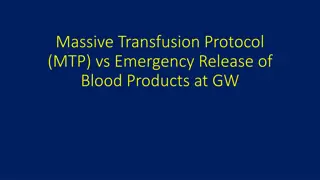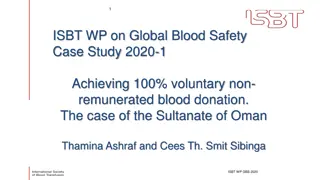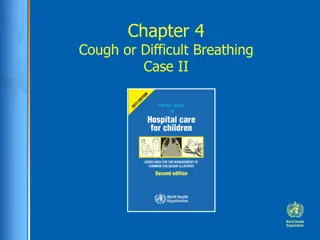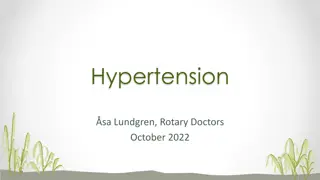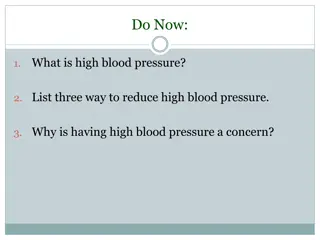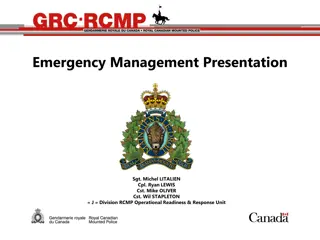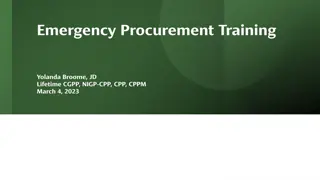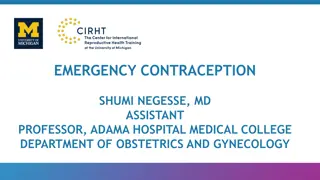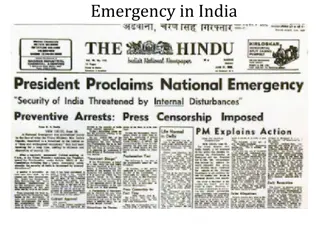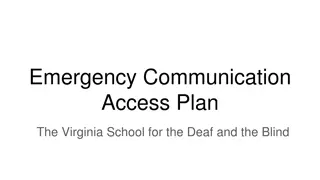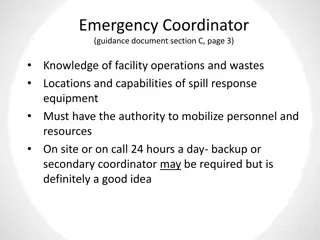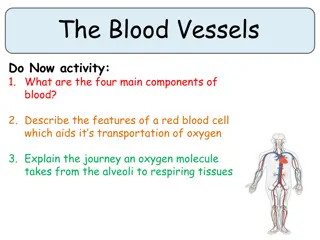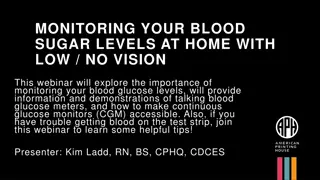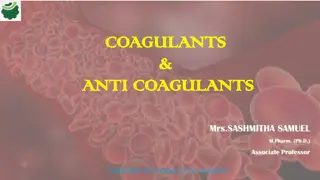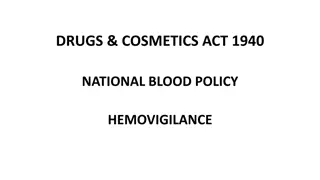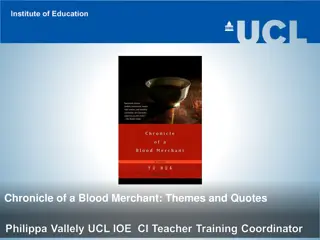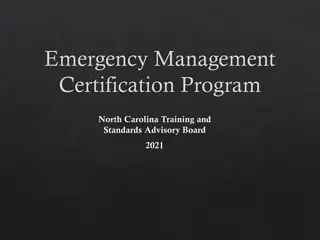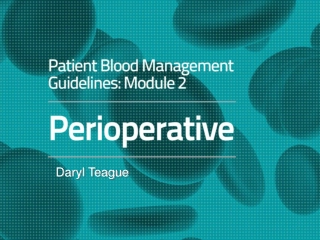Emergency Management of Massive Blood Loss: A Case Study
This case study details the emergency management of a 72-year-old female patient with massive blood loss due to esophageal varices, providing insights into assessment, resuscitation, and treatment strategies to stop bleeding, replace losses, and prevent worsening. Key considerations include the principles of resuscitation, stopping bleeding techniques, and the importance of preventing coagulopathy to improve patient outcomes.
Download Presentation

Please find below an Image/Link to download the presentation.
The content on the website is provided AS IS for your information and personal use only. It may not be sold, licensed, or shared on other websites without obtaining consent from the author. Download presentation by click this link. If you encounter any issues during the download, it is possible that the publisher has removed the file from their server.
E N D
Presentation Transcript
Massive Blood Loss (and some transfusiony bits) Ms C Thompson Consultant in Emergency Medicine Peterborough City Hospital
Case to consider Case to consider 72 yr old female pt Known oesophageal varices due to NAFLD PR bleed ETA 10 minutes Obs: RR 20, Sats 91% P 112, BP 93/47 T36.6 C, BM 10.4
On Arrival On Arrival Pale Active bleeding PR Talking RR 20, Sats 91% RA (97% on 4l) BP 77/36 P 120 Cardiorespiratory system intact GCS E3 V5 M6 Abdomen distended, non-tender, soft. T36 C
Principles Principles 1. Stop the Bleeding 2. Replace losses 3. Prevent worsening
Stopping Bleeding Stopping Bleeding General Specific TXA? Terlipressin Variceal banding (OGD) Surgery Sengstaken tube
Resuscitate Resuscitate Principle of Like for like Blood What are you aiming for?
Prevent Worsening Prevent Worsening Why does the situation spiral downhill?
Prevent Worsening Prevent Worsening Haemodilution Consumption Drugs / PMHx [Calcium] Coagulopathy Hypoperfusion BLEEDING Fluids Hypothermia Acidosis Examination Procedures
Evidence Evidence German Trauma Registry 17200 Patients 8000 coag data complete Bleeding was the major cause of death 34% Coagulopathic on arrival
Probability of Coagulopathy ISS >25 SBP <70 pH <7.1 T <34 C Probability No Risk Factors <1% x 10% x x 39% x x 58% x x x 85% x x x x 95%
Independent predictor of mortality Baseline Coagulopathy Multi-Organ Failure 11% 28% In hospital mortality 2% 12% Mortality within 24 hrs 8% 26%
Therefore Therefore Use blood & avoid hypoperfusion Replace coagulation factors Remember platelets Remember other factors Ca2+, Fibrinogen Keep warm
What to use? What to use? Mortality from: pRBCs 8 2.5 1.4 FFP 1 1 1 Mortality 65% 30% 28%
Non Non- -Traumatic Bleeding Traumatic Bleeding rAAA Package of blood 1:1 package vs normal practice Decrease in mortality
European Guidelines 2007 European Guidelines 2007 Decrease the time from injury to surgery If source of bleeding unknown, imaging should be used Damage Control Surgery Use of blood products, coagulation factors & drugs
Update 2019: 5 Update 2019: 5th th Ed Rapid transport to specialist MTC Edn n Early monitoring & support of coagulation with goal- directed treatment strategy. Damage Control Surgery. Coagulation support / thromboprophylactic strategies should consider trauma patients who have been pre- treated with anticoagulants or platelet inhibitors. Local adherence to a multidisciplinary, evidence-based treatment protocol with audit
Update 2019: 5 Update 2019: 5th th Ed Rapid transport to specialist MTC Edn n Early monitoring & support of coagulation with goal- directed treatment strategy. Damage Control Surgery. Coagulation support / thromboprophylactic strategies should consider trauma patients who have been pre- treated with anticoagulants or platelet inhibitors. Local adherence to a multidisciplinary, evidence-based treatment protocol with audit
Update 2019: 5 Update 2019: 5th th Ed Rapid transport to specialist MTC Edn n Early monitoring & support of coagulation with goal- directed treatment strategy. Damage Control Surgery. Coagulation support / thromboprophylactic strategies should consider trauma patients who have been pre- treated with anticoagulants or platelet inhibitors. Local adherence to a multidisciplinary, evidence-based treatment protocol with audit
Update 2019: 5 Update 2019: 5th th Ed Rapid transport to specialist MTC Edn n Early monitoring & support of coagulation with goal- directed treatment strategy. Damage Control Surgery. Coagulation support / thromboprophylactic strategies should consider trauma patients who have been pre- treated with anticoagulants or platelet inhibitors. Local adherence to a multidisciplinary, evidence-based treatment protocol with audit
Update 2019: 5 Update 2019: 5th th Ed Rapid transport to specialist MTC Edn n Early monitoring & support of coagulation with goal- directed treatment strategy. Damage Control Surgery. Coagulation support / thromboprophylactic strategies should consider trauma patients who have been pre- treated with anticoagulants or platelet inhibitors. Local adherence to a multidisciplinary, evidence-based treatment protocol with audit
Update 2019: 5th Edn 1. Initial resus & preventn further bleeding 2. Diagnosis /monitoring of bleeding 3. Tissue oxygenation, volume, fluids, temp 4. Rapid control of bleeding 5. Initial Mx bleeding & coagulopathy 6. Goal directed clotting management 7. Reversal of anti-thrombotics 8. Thromboprophylaxis
So What? So What? Basic principles the same Extrapolated to civilian population Many more patients on DOACs / anti-platelets / anti-coagulants How do we do it? (Get to the point)
Case to consider Case to consider 72 yr old pt Known oesophageal varices due to NAFLD PR bleed ETA 10 minutes Obs: RR 20, Sats 91% P 112, BP 93/47 T36.6 C, BM 10.4
Treated with Blood O negative MBL protocol activated 2 units pRBCs given Cryoppt Measured coagulation, calcium, pH Hb, Fibrinogen, INR
The 10 Commandments The 10 Commandments 1. Transfusion should only be used when the benefits outweigh the risks and there are no appropriate alternatives. 2. Results of laboratory tests are not the sole deciding factor for transfusion. 3. Transfusion decisions should be based on clinical assessment underpinned by evidence-based clinical guidelines. 4. Not all anaemic patients need transfusion 5. Discuss risks, benefits and alternatives to transfusion with patients and gain consent.
The 10 Commandments The 10 Commandments 6. Reasons for transfusion should be documented in notes. 7. Timely provision of blood components in major haemorrhage can improve outcome good communication and team work are essential. 8. Failure to check patient identity can be fatal. Confirm identity at every stage of the transfusion process. Patient identifiers on ID band and blood pack must be identical. Any discrepancy, DO NOT TRANSFUSE. 9. Patients must be monitored during the transfusion. 10. Education and training
Further Reading Further Reading Spahn et al. Critical Care (2019) 23:98 https://doi.org/10.1186/s13054-019-2347-3 https://www.transfusionguidelines.org/transfusion- handbook East of England pages https://www.transfusionguidelines.org/uk- transfusion-committees/regional-transfusion- committees/east-of-england/policies https://www.nice.org.uk/guidance/ng24/chapter/Re commendations



